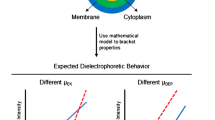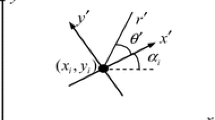Abstract
Because of the increasing use of dielectrophoresis in the dielectric characterization and sorting of living cells or their parts, it has become important to establish carefully the theoretical backgrounds for this effect. A comparison with experiment is made of the several versions of the theory for the dielectrophoretic force exerted by nonuniform electric fields upon a neutral object. The three fundamental approaches: the Maxwell-Strattonstress tensor, the effective dipole moment, and the ‘Helmholtz’ energy approach are presented along with the general solution given earlier by Pohl and Crane. These are found to agree closely with experiment in predicting the dielectrophoretic force upon various rods hung in specially shaped (isomotive) field distributions. On the other hand, an alternative formulation based upon a debatable assignment of fields local to the dipoles gave a good fit to the experimental data only for materials of very low permittivity, and fitted poorly in the case of highly polarizable materials.
An improved derivation of the theory for stable dielectrophoretic levitation is also presented. This phenomenon is of particular interest in that it is based upon an apparent violation of the Earnshaw's theorem, and is useful in the study of the dielectric properties of individual living cells.
Similar content being viewed by others
References
D. J. Korteweg, Wied. Ann. der Physik und Chemie9, 48–61 (1880).
H. von Helmholtz, ibid13. 385 (1881).
M. Abraham and R. Becker. 1932.Classical Electricity and Magnetism, Blackie Ltd., London.
J. A. Stratton, 1941,Electromagnetic Theory, McGraw-Hill Book Co., N.Y.
E. Durand, 1953,Electrostatique et Magnetostatique, Masson, Paris.
J. Larmor, Phil. Trans. Roy. Soc. A190, 280 (1897).
G. H. Livens, Phil. Mag.32, 162 (1916).
R. Cade, Proc. Phys. Soc. A,64, 665 (1951).
S. S. Hakim, Inst. Elec. Engrs., Monograph 475M, (1961).
S. S. Hakim and J. B. Higham, Proc. Phys. Soc.80, 190 (1962).
H. A. Pohl, J. Appl. Phys.22, 869 (1951).
A. R. von Hippel, Dielectrics and Waves, John Wiley & Sons, N.Y., 1954, p. 39.
H. A. Pohl, J. Appl. Phys.29, 1182 (1958).
L. D. Sher, Nature220, 695 (1968).
H. A. Pohl and J. S. Crane, J. Theor. Biol.37, 1 (1972).
J. S. Crane and H. A. Pohl, ibid.37, 15 (1972).
M. Javid and P. M. Brown,Field Analysis and Electromagnetics, McGraw-Hill, N.Y., 1963.
J. Neufeld, Phys. Rev.152, 708 (1966).
P. Lorrain and D. Corson,Electromagnetic Fields and Waves, W. H. Freeman and Co., San Francisco, 1970, p. 135.
O. Jefimenko,Electricity and Magnetism, Appleton-Century-Crofts, N.Y., 1966.
L. D. Landau and E. M. Lifschitz,Electrodynamics of Continuous Media, Pergamon Press, New York, 1960.
J. Neufeld, Il Nuovo Cimento, LXVB,33 (1970); LXVIB,51 (1970).
J. Neufeld, Int. J. Electronics27, 301 (1969).
G. Schwartz, J. Chem. Phys.39, 2387 (1963).
J. S. Crane and H. A. Pohl, J. Electrostatics5, 11 (1978).
T. B. Jones and G. W. Bliss, J. Appl. Phys.48, 1419 (1977).
W. F. Brown, Jr., Amer. J. Phys.19, 333 (1951).
H. Greinacher, Helv. Phys. Acta.21, 261 (1948).
R. M. Fano, L. J. Chu, and R. B. Adler,Electromagnetic Fields, Energy, and Forces, p. 356, John Wiley & Sons, New York, 1960.
J. A. Reynolds and J. M. Hough, Proc. Phys. Soc.B70, 769 (1957).
H. A. Pohl and R. Pethig, J. Phys., E,10, 190 (1977).
D. S. Parmar and A. K. Jalaluddin, Jap. J. Appl. Phys.13, 793 (1974).
J. H. Winckler,Essai sur la Nature, Effets et les Causes de l'Electricite', Vol. 1., Sebastian Jorry, Paris, 1748.
J. C. Maxwell,A Treatise on Electricity and Magnetism, (Dover, New York, 1954) Article 116.
L. Epstein, Amer. J. Phys.33, 406 (1975).
H. A. Pohl,Dielectrophoresis, Cambridge University Press, 1978.
Author information
Authors and Affiliations
Rights and permissions
About this article
Cite this article
Pohl, H.A., Pollock, K. & Crane, J.S. Dielectrophoretic force: A comparison of theory and experiment. J Biol Phys 6, 133–160 (1978). https://doi.org/10.1007/BF02328936
Issue Date:
DOI: https://doi.org/10.1007/BF02328936




